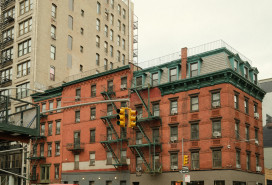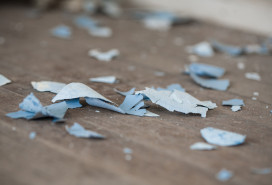How to uncover the history of your NYC apartment building

When Brian Hartig and his husband first bought a brownstone in Bed-Stuy and set about the process of renovating it, almost immediately "things started falling out of the walls," he recalls. "We were finding them under the floor boards." The "things," it turned out, were artifacts left behind by the families who had lived in the house before them.
"I had a regular curio cabinet full of objects by the time we were done," he says, including Victorian children's blocks from the 1890s, a shoe catalog, and an old receipt dating back to the 1910s. These random finds sparked Hartig’s interest in the history of his new home, and he started to research it in earnest, ultimately finding records showing that the property was farmland the 1700s and owned by Jacobus van de Water, mayor of New Amsterdam in 1673.
[This article was originally published in July 2017.]
These days, Hartig does this kind of research for a living at his company, Brownstone Detectives, taking requests from clients who want to know more about their homes, doing the research for them, and putting it all into a book at the end of the process. "Clients tell me what they want to know and I get to follow the clues….We’ve uncovered stories of Baseball Hall of Famers, murderers, Civil War heroes, unexplained fires, explosions, deceit, corruption, unrequited love, and much, much more."
Starting your own search
If you're interested in uncovering details about your own abode—from when it was built, to what your neighborhood used to look like, to who used to live there—the city has a surprising number of resources available for armchair history buffs.
"New York City easily has the most resources and accessible documentation," says Sarah Bean Apmann, Director of Research and Preservation for the Greenwich Village Society for Historic Preservation. "In researching a building one is bound to find at least some information on who built it, who lived in it, and/or what businesses may have occupied it."
As such, you hardly have to be a PhD-level researcher to dig up some valuable information. "Don't reinvent the wheel," advises Anthony W. Robins, architectural historian, former Director of Survey at the New York Landmarks Commission, and author most recently of “New York Art Deco: A Guide to Gotham’s Jazz Age Architecture. (Robins also teaches a course on NYC building research each year at the Municipal Art Society -- his next is scheduled for September.)
It may be that someone has done the research on your building already and published it online. If you are lucky enough to live in a building or historic district that has received official landmarking status from the NYC Landmarks Preservation Commission, your work will have been done for you. If your building has been landmarked, that will be indicated on the NYC Department of Buildings' Building Information Site (BIS) website. And if you're not sure whether you live in a historic district, there's a map you can consult here.
If your building has made the cut, you will be able to find a detailed designation report on the LPC's Designation Reports page—and that may well provide all the information you need or want to know.
If your building is located in the catchment area of the Greenwich Village Society for Historic Preservation (roughly river to river from West 14th to Houston Street), check with their staff—they have done reports on buildings that may not have been formally landmarked. Or if you’re on the Upper West Side of Manhattan, go to Landmark West’s database—it’s quite thorough and easy to use.
If your building is on the National Register, you can get a copy of the historical report at http://www.oprhp.state.ny.us/hpimaging/. "This can take some doing," warns Robins, who includes a how-to on his site, linked in the next section below.
If the research on your building hasn’t already been done by someone else and you want to do your own detective work, we recommend that you begin with two excellent on-line sources: “Who Lived in a House like This?” The New York Public Library's research tool and “Intro to Online Research Resources” Robins’ website tool. Though not as comprehensive, the GVSHP website has two pages (here and here) with good start-up tips, as well.
Further resources for an in-depth search:
If your building does not fit into any of the above categories, here are some resources that Apmann suggests you try:
Maps
- Fire insurance maps—commissioned by insurance companies when many of the city’s buildings were made of wood and fire was a very real danger--are some of the most detailed city maps ever published. On this terrific website, the earliest map is from 1815; you can search easily by borough.
- More ingenious work by the NYPL: you can click on a location and you will get an overlay of an historic map over a current day map.
Newspapers
- The New York Historic Newspapers website has 7,066,433 pages of newspaper articles that can be searched county by county. They’ve recently added “The Villager” to their data base which makes Apmann particularly pleased.
- The New York Times Archives are a treasure trove of information, with a record of articles dating all the way back to 1851. (Note: you need to be a subscriber to access these from your own computer.)
- The Brooklyn Daily Eagle has some excellent information about real estate in their archives, not just in Brooklyn but in other boroughs as well, dating from 1841-1955.
City Directories
- The NYPL recently digitized NYC city directories from 1786 (!) to 1923, with more to come. Apmann explains that, “This was our telephone book before there were telephones.” If you have a person’s name, you can find out where he/she lived and what his/her occupation was. One random search from an 1852 directory lists Henry Allison who lived at 2018 Avenue B and was a blacksmith.
- The Stephen Morse Unified Census ED (Enumeration District) Finder, described as “tremendous” by Apmann, allows you to find your street address in census records between 1880 and 1940.
Real Estate Records
The Real Estate Record and Guide was once the go-to guide for all things real estate in the city and it’s where you’ll find building permits and lots of other interesting real estate news (and ads that are lots of fun to read) dating from March 1868 to December 1922.
Photos
- Another tool from the NYPL’s Digital Collection, this one has historic photos of the city and is about as user friendly as you can get--just click on a spot on the map and photos of that area pop up.
- The Museum of the City of New York has digitized 185,000 images and objects from their collection.
- Images from NYC’s amazing Municipal Archives collection including photos, maps, motion pictures and audio are fun to explore, whether or not you’re doing research. In 1940 and again in 1980, the city commissioned photographs of every building in the five boroughs (!) for tax assessment purposes. The 1980 photos are online; the 1940 version, not yet but can be seen by paying a visit to the Archives.
You Might Also Like






























